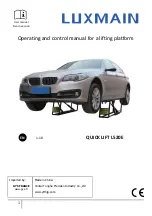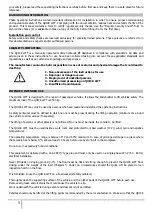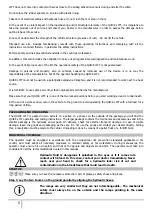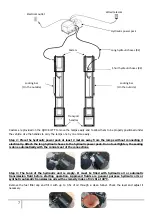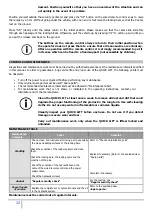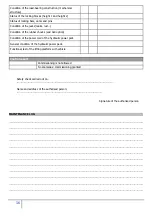
11
She won't be able to lift a vehicle in some cases. It's not a malfunction. This can be problematic if, for example, you
lift a vehicle and once raised you remove the wheels and return the QUICK LIFT to its original position (on the
ground). When you want to pull the vehicle up, the QUICK LIFT will not be able to do so. In this case contact your
dealer or the manufacturer for assistance.
Please never go below height 1 if the vehicle has the wheels removed. And make sure that both locking bars are
locked if the vehicle is to remain in this position for a long time.
Ramps in lifting position:
When raising and lowering vehicles, always leave your ramps in the locked position using the locking bars. Not all lifts
on the market, including the QUICK LIFT, are designed to hold their full load unless they are placed in the locked
position.
For deploying Quick Lift ramps and lifting a vehicle:
a.
Verify that the vehicle's hand brake is off and that there is no gear engaged before deploying the ramps (please
refer to the vehicle manual in some cases for the procedure).
b.
Insert the rubber spacers on the ramps and in the areas provided for this purpose.
c.
Press and hold the "UP" button on the remote control. The ramps are starting to deploy.
d.
Just before the rubber chocks make contact with the vehicle chassis, release the "UP" button.
e.
Check the areas where the rubber chocks will come into contact with the vehicle chassis. If necessary, adjust
the rubber lifting wedges at the undercarriage pick-up points (manufacturer's recommendation).
f.
Press the "UP" button on the wired control. When the vehicle leaves the ground, do not stop the deployment of
the ramps until the first locking position is reached. Never leave a vehicle elevated unless both safety bars are
in the locked position.
g.
Test the stability of the vehicle: if this is not the case, return the vehicle to the ground immediately by pressing
"DN" (descend) and check the cause before raising the vehicle.
h.
Raise the vehicle to either Lock Height 1 or Lock Height 2. When you have reached the desired locking position,
press "DN" (down) on the remote control to lower and bring both ramps to the locked position.
i.
Make sure that both ramps are in the locked position and that all rubber chocks are in contact with the vehicle.
j.
Once these 2 points have been checked, carry out a stability test to check that the car is stable.
k.
It is after these 3 tests that you will be able to work safely around and under the vehicle.
The manufacturer will not assume any civil or criminal liability for damage caused
to persons if the operator does not comply with the above recommendations.
Never stand around or under the QUICK LIFT if you have to remove a heavy
object from the vehicle (engine, gearbox...). The vehicle could become
unbalanced and cause the QUICK LIFT to tip over. Do not take any risks, always
be outside the safety zone (minimum 2m) during an ascent or descent
manoeuvre.
Descent:
Before carrying out the lowering manoeuvre, check that there are no persons or
obstacles in the safety area. Also check that there are no obstacles in the booms,
that the hydraulic hoses and the remote control cable do not obstruct the booms'
Summary of Contents for LUXMAIN QUICK LIFT L520E
Page 17: ...17...

